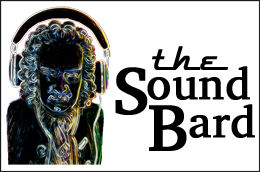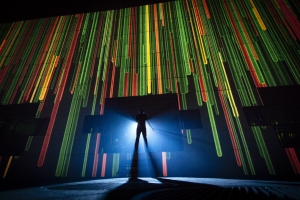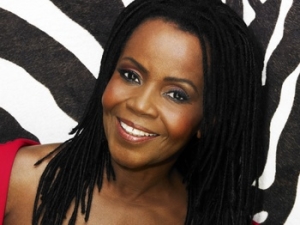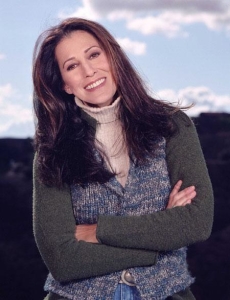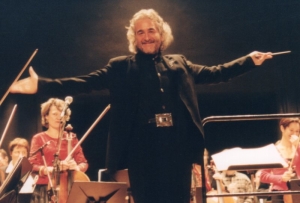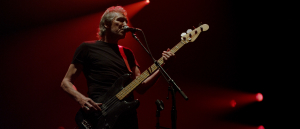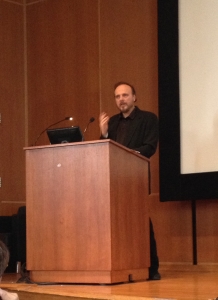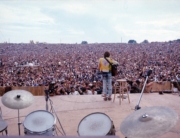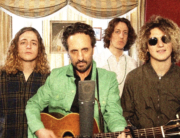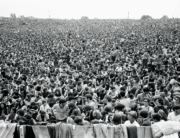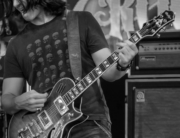BY MIKE METTLER — SEPTEMBER 25, 2015
Good things come to those who wait, as the saying goes. But when it comes to finally getting producer/engineer James Guthrie’s long-awaited 96kHz/24-bit mix of Roger Waters’ 1992 solo album Amused to Death in 5.1 on Blu-ray in hand, well… the word “good” isn’t quite good enough. “Great” is certainly a step up, but I’m going to have to go with a superlative along the lines of “stellar,” “outstanding,” and/or “stunning,” for Guthrie’s surround-sound treatment of Amused catapults an oft-overlooked entry in Waters’ storied canon of work into a new sonic stratosphere.
Waters himself certainly agrees: “The new mixes of Amused to Death sound stunning,” he told me as we sat together at the Sony Club in New York in mid-September. “I always loved listening to this album in stereo when it was just in QSound, but this 5.1 mix by James is pretty amazing. I can now imagine presenting the new material I’m currently working on in surround. There’s a song I’ve written with an old Irishman and his grandson talking at the top of a mountain while the sounds of battle are going on in the valley everywhere around them. I think that could be quite stunning in 5.1.” (Note to Guthrie: Add that to your already burgeoning surround-mixing queue, ASAP!)
During “Pink Floyd: Sound, Sight, and Structure — Interdisciplinary Conference,” the first ever academic conference devoted to the mighty Floyd that was held at Princeton University in New Jersey on April 10-13, 2014, Guthrie and his assistant engineer Joel Plante hosted two world-premiere listening sessions for Amused in 5.1, in addition to Guthrie’s groundbreaking 5.1 mixes of a nice pair of Floyd’s most indelible works, The Dark Side of the Moon (1973) and Wish You Were Here (1975). Even then, Guthrie admitted in his opening remarks that Amused was the most complicated surround mix he’d worked on to date. (Go here for more of my take on the sights and sounds of the Interdisciplinary Conference.) And now, almost a year-and-a-half later, you can cue up Amused 5.1 on Blu-ray for yourself (via Columbia/Legacy) and become fully immersed in an album that bears re-assessment and repeated spins.
Recently, Guthrie and I spent a fair amount of time going over his goals for bringing Amused into the surround universe and sharing his favorite moments from Dark Side and Wish in 5.1, plus he reveals exclusively what Floyd-related project he’ll next tackle in 5.1. It’s a miracle — another miracle.
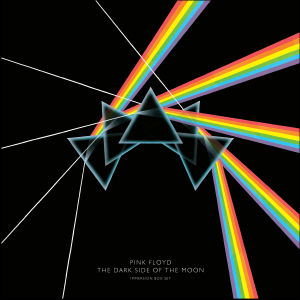 Mike Mettler: You’ve mixed some of Roger’s earlier music from the Pink Floyd canon in 5.1 — namely, The Dark Side of The Moon and Wish You Were Here. Can you compare/contrast the differences in mixing Dark Side and Wish You Were Here with Amused to Death?
Mike Mettler: You’ve mixed some of Roger’s earlier music from the Pink Floyd canon in 5.1 — namely, The Dark Side of The Moon and Wish You Were Here. Can you compare/contrast the differences in mixing Dark Side and Wish You Were Here with Amused to Death?
James Guthrie: They all presented their own unique challenges, both musically and technically. The Dark Side of The Moon did because I decided to go back to an earlier generation of multitrack tapes that were never intended to synchronize with the final version. Musically, the challenges with that album were tricky, because the work is indelibly printed on so many people’s minds, and they expect a particular emotional response. The 5.1 mix had to be faithful to the original stereo mix and deliver at least the equivalent, or hopefully an even better, emotional listening experience.
While mixing in 5.1, I’m regularly comparing what I’m doing to the original stereo mix, to make sure it is achieving the desired result. Creatively, the same applied on Wish You Were Here. You can’t resort to trickery — the mix must work musically first. Then you can try out all the theatrics.
Being given the opportunity to re-approach such important pieces of work is a great privilege. You have so many creative options. This music really lends itself to the surround experience. Pink Floyd were early pioneers of the quadrophonic live show, so this is a natural progression for them. To be able to create the feeling of being truly enveloped and immersed is great fun.
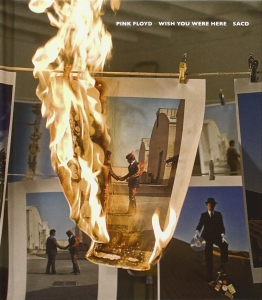 Mettler: Can you give me examples of your favorite songs and/or moments from your 5.1 mixes for Dark Side and Wish You Were Here, and why they’re important to you from a sonic standpoint?
Mettler: Can you give me examples of your favorite songs and/or moments from your 5.1 mixes for Dark Side and Wish You Were Here, and why they’re important to you from a sonic standpoint?
Guthrie: I suppose some standouts may be:
On WYWH 5.1, the song “Wish You Were Here” for me rivals the original stereo mix for musical feel, and I like the motion and dynamic of “Shine On You Crazy Diamond (Parts 6-9).” Instrument positioning is also nice on “Welcome to the Machine.”
On TDSOTM 5.1, I like that we now have an increased spatial feel, while still retaining the musical integrity of a band playing in a room. When you dismantle TDSOTM, you recognize the brilliance of the musical arrangements. There’s a blend of guitars and keyboards, often playing in the same register and often through Leslies and Uni-Vibes, which creates a beautiful, watery sound.
My approach to the 5.1 mix of Amused to Death was similar. There’s a lot of prep work on all of these projects, but Amused to Death certainly wins on that front. I’m happy that the album finally gets a second chance to be heard. Roger’s profile as a solo artist was not as high in those days, and the release just didn’t get the exposure it deserved.
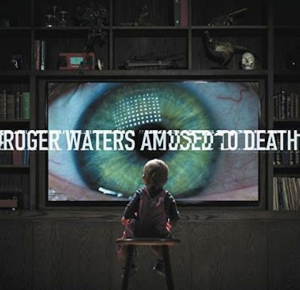 Mettler: Would you still agree with what you said at last year’s Conference — that Amused to Death was one of the most complicated and complex mixes you’ve worked on in your career, both in terms of stereo and surround?
Mettler: Would you still agree with what you said at last year’s Conference — that Amused to Death was one of the most complicated and complex mixes you’ve worked on in your career, both in terms of stereo and surround?
Guthrie: Without question, the most complex. There are so many different atmospheres and musical elements and styles.
Mettler: Why do you think that is?
Guthrie: When I started work on the project, I noticed the shape of it begin to change almost daily, and I realized that Roger was still “discovering” the record — even though at more than one point during its evolution, he felt it was finished. He actually had a few “completed” versions — the first with Nick Griffiths, the second with Patrick Leonard, and, I suppose, a third when I came in. This all contributed to its complexity.
The fact that the album “evolved” is a big factor. “The Ballad of Bill Hubbard,” for instance, wasn’t even part of the record at that point. It began as a jam with Pat [Leonard] playing keyboards and Jeff Beck playing guitar, and it filled most of a reel of tape — nearly 15 minutes. We edited our favorite sections together, and Roger suggested adding the voice of Alf Razzell [of The Royal Fusiliers]. After numerous further additions, suddenly, it was the opening song on the record.
Even the crossfades between songs became musical passages in their own right. Normally, a crossfade consists of the end of the outgoing song and the beginning of the incoming song, possibly with the addition of an atmospheric or musical component. Many of the crossfades on Amused to Death became multitrack mixes in their own right, as we added more and more details.
Mettler: As to the lyrical content of the album itself, how amazingly prescient Roger was — and is! — about the prevalence of video culture and “the distracted life.” Isn’t that something? Did you feel your 5.1 mix had to reflect that overarching subject matter?
Guthrie: Absolutely! And I thought about that regularly when mixing. The message is so important, and Roger expresses it so well. It’s been something that I’ve been acutely aware of from an early age — probably since reading Brave New World and 1984 as a kid — so the gravity of the album’s message was not lost on me. Song lyrics are very important to me, and one of my favorite things about working with Roger is that he usually has something important to say, along with the ability to express it eloquently.
Mettler: Most if not all of the TV audio appears in the rear left channel of the mix, which must have been a deliberate decision. Why did you decide on using that channel for the TV audio?
Guthrie: It’s actually supposed to be more three-quarter left. I was just bringing the sound out into the room to make use of the 5.1 soundstage. On the stereo mix, we had a sort of half-left setup for the TV using QSound, and I decided to exaggerate that position a bit on the new mix. It was important to establish a position for the television so that it became a stable reference for the narrative.
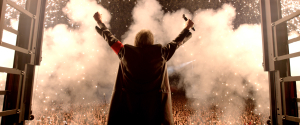 Mettler: This may be a bit of an obvious question, but I think it’s invaluable to get your POV on it: What is the optimal position a listener should take to get the most out of Amused to Death in 5.1?
Mettler: This may be a bit of an obvious question, but I think it’s invaluable to get your POV on it: What is the optimal position a listener should take to get the most out of Amused to Death in 5.1?
Guthrie: Directly in the middle! Actually, I like to be ever so slightly in front of that position. I’ve heard some mixes that sound a bit “rectangular,” or narrow, so I try to create a circular space with the 5.1 soundstage in order to offer a three-dimensional experience, even if the listener is off-axis. The most difficult area to fill when creating that circle is the area directly to your left and right — if you are sitting in the middle — and we have to work with that challenge.
The easiest way to make a sound appear to be coming from a point source is to put a speaker there. Obviously, this is not possible with the agreed upon 5.1 configuration, although we do recommend placing the rear speakers further back than the original ITU specification dictated. This is detailed in the included sound-setup page on the ATD Blu-ray.
With the circular approach, it’s interesting to me how, even when standing outside of the circle, you still seem to get a three-dimensional musical experience.
Mettler: How much back-and-forth did you have to do to determine the depth of the subwoofer impact for the detonations/explosions that occur in “Late Home Tonight, Part I,” circa the 26-minute mark of the album? I can tell you that a nearby stack of Blu-rays cascaded to the floor when that moment occurred on my system! What were your overall goals for the album’s low-end impact?
Guthrie: Punchy and full, with moments of, “Holy shit! What just happened?!” over-the-top drama. I guess that could be “mission accomplished” if your discs crashed to the ground!
Once your mix room is set up correctly, there doesn’t have to be too much back-and-forth; you just set things where they feel right. Having said that, I am constantly thinking about how it will translate on different playback systems. The sub and center speakers can be difficult to second-guess — you just don’t know how certain home systems may be calibrated. Some home systems may have a completely different speaker in the center, or none at all. Same for the sub. That’s one of the reasons we include a system-setup page on the Blu-ray.
Mettler: Roger’s vocals appear to take on different tones from song to song, which serves to add to the overall character/direction of each’s song’s specific subject matter. Did you make individual tweaks/adjustments to ensure they come across that way?
Guthrie: Yes, each one is tailored to its song and lyric. It’s a fine balance between keeping Roger’s voice as the focal point while making sure he’s still “in the same room” as the other musicians.
Mettler: How did you decide to put a surround effect on a word/lyric, such as the echo/repeat of the word “lied” in “What God Wants, Part I”? Does the very nature of the word/subject lend itself to an “instinctual” kind of decision?
Guthrie: Yes, it is most definitely a feel thing. Sometimes you’re deliberately drawing attention to a word, and sometimes you’re adding to an atmospheric space or creating a rhythmic punctuation, but it has to be musical.
For some reason, I instinctively respond to the song with that sort of thing. When we were recording the vocal for “Nobody Home” on [1979’s] The Wall album, for example, as soon as Roger had finished singing, I put the long “telephone” delay on his voice. Often these things are added on the mix, but when it plays such a prominent role — and I want people to get used to it! — I’ll print the effect right away.
On Amused to Death, possibly because I came in after the recording for the project was underway, I did most of the effects “live” on the mix, which meant I had to re-create them on the 5.1.
Mettler: On “Watching TV,” I loved hearing the blend of Roger’s and Don Henley’s vocals — sometimes, with Henley just a micro-step behind. Did you have different goals/approaches for some of the other vocalists on the album — such as PP Arnold and Rita Coolidge — as to how they worked with/blended with Roger?
Guthrie: That blend of voices works really well doesn’t it? Originally, Roger had intended to add John Prine on “Watching TV,” as he’s a fan of John’s. We tried it, and the vocal phrasing on the song is so specifically Roger Waters, and what JP does is very specific to him. His voice was great, but just didn’t work with Roger’s. Unfortunately, he couldn’t match the phrasing.
What works so well for me about Henley — apart from the great blend of their vocal timbres — is the arrangement: The fact that they trade Roger high/Don low, and vice versa, at just the right moments.
Pat Arnold is such a great singer. On “Perfect Sense, Part 1,” she takes over the lead vocal, so the approach was just to frame her properly, to make her sound as important as possible. Easy to do when you’re dealing with a voice like that!
Rita was a great choice for Amused to Death — another really good blend for Roger and a very charismatic voice regardless of whether she’s harmonizing, or singing lead. And she brought additional atmosphere with her spontaneous laugh on the Jessica Hahn line, which we left in [“When Jessica Hahn goes down”]. At times, she’s placed centrally with Roger; at others, slightly off to the right.
Mettler: Tell me about working Jeff Beck’s guitar tracks. The character of what he contributes is so unique, you instantly know it’s him playing, down to every last bend, shift, and warble. Did you have any discussions with Jeff about any of that at all?
Guthrie: He is staggering, isn’t he? Sadly, I didn’t get to speak to him about the performances, as his guitars were already recorded by the time I came to the project. I just wanted to find the right space for him, to maximize his emotional impact. He is so brilliant and brought that amazing melodic flare to the album. At times lyrical, at times explosive, always commanding, his expression immediately inspires and directs you to do the right thing with delays and reverbs.
Mettler: I especially like how you move him around in “Three Wishes.”
Guthrie: The placing on “Three Wishes” is half-right for the guitar and a kind of half-left, but more “in the room” position for the delay, which I added with an analog tape-delay unit.
Mettler: Do you have a favorite moment/sequence of his on the album?
Guthrie: It’s difficult to pick a favorite. I’m a big Jeff fan, so whenever he plays, I’m listening, but I love the solos in “What God Wants, Part III” and “Three Wishes.” “The Ballad of Bill Hubbard” is deeply moving, and the little cries at the end of “Amused to Death” bring you straight back into that emotional space.
Mettler: I’d also like to get your impressions about working with Michael Kamen’s orchestral contributions, as well as the vocal choirs.
Guthrie: Michael was another absolutely brilliant musician. The standard of musicianship is pretty high on this record, isn’t it?! His musical contribution is huge, his sense of humour always lurking. Michael’s cheeky personality is present in most of his arrangements, from the lush slurs in “God III” to the ’50s playfulness in “Late Home Tonight.” Michael had a great understanding of the orchestra and knew how to say the right thing at precisely the right moment. I love the way he wrote for woodwinds. Michael played the oboe, which I suppose would explain why he understood that section so well. [Kamen passed away in 2003.]
Using a real choir contributed strongly to the theatrical element of the record. It just sounds important. When you’re telling stories, you have to be convincing, and Roger understands just how to do that. The “real thing” dramatically supports his lyrics.
Mettler: The pinging effect heard around the 38:27 mark, in “What God Wants, Part III” — is that a deliberate nod to Pink Floyd’s “Echoes” [from 1971’s Meddle]? And did I also hear some whale sounds in that track as well?
Guthrie: Absolutely a nod, yes. It’s a piano fed through a Leslie speaker, just as it was on “Echoes.” I think what you may be hearing as whale-like sounds is a section of the introduction that I dropped to half-speed and then played backwards. It does have a certain low, organic moan to it.
Mettler: Do you have an overall favorite track/mix on the album?
Guthrie: I really love this album. As I’ve mentioned in the past, I think it contains some of Roger’s finest work and succeeds as a conceptual piece, so it’s difficult to pick a favorite — though I do particularly enjoy the last group of three songs, from “Three Wishes” through “It’s A Miracle” and “Amused to Death.”
Mettler: Can you discuss any of your future hi-res/5.1 (re)mixing plans? Have you and Roger discussed doing other albums from his solo canon, such as [1984’s] The Pros and Cons of Hitchhiking and [1987’s] Radio K.A.O.S., or other Floyd material like [1977’s] Animals?
Guthrie: I’m going to be starting a 5.1 mix of The Wall soon — the original studio album, that is. And we have discussed Animals. We haven’t talked about Pros and Cons or K.A.O.S., but you never know!
Mettler: Fingers crossed, then! Do you have a personal “dream” project or projects you’d love to sink your remixing teeth into, so to speak? When he and I were talking last year, Nick Mason told me he’d love to hear Meddle and [1968’s] A Saucerful of Secrets — and especially the song “Set the Controls for the Heart of the Sun” — get 5.1 mixes, as well as some of Pink Floyd’s earliest, Syd Barrett-era recordings.
Guthrie: In addition to The Wall, I want to do Animals and The Final Cut. The very early work that was recorded on 4-track would be tricky, obviously, because there is less discrete information available, but I agree with Nick: Meddle would be fun.
Tags: 5.1, A Saucerful of Secrets, Amused to Death, Animals, David Gilmour, Don Henley, Echoes, It's a Miracle, James Guthrie, Jeff Beck, Joel Plante, John Prine, Late Home Tonight, Meddle, Michael Kamen, Nick Griffiths, Nick Mason, Nobody Home, Patrick Leonard, Perfect Sense, Pink Floyd, PP Arnold, QSound, Radio K.A.O.S., Richard Wright, Rita Coolidge, Roger Waters, SACD, Set the Controls for the Heart of the Sun, Shine On You Crazy Diamond, surround sound, Syd Barrett, The Ballad of Bill Hubbard, The Dark Side of the Moon, The Final Cut, The Pros and Cons of Hitchhiking, The Wall, Watching TV, Welcome to the Machine, What God Wants, Wish You Were Here